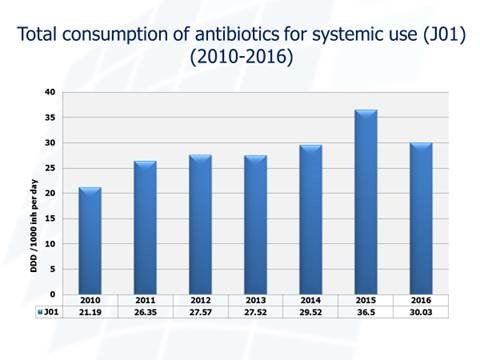It is estimated that annually about 700,000 people die as a result of community or hospital based infectious diseases caused by bugs resistant to antimicrobials. A recent report by the World Bank, entitled Drug-Resistant Infections: A Threat to Our Economic Future, reported that if effective measures are not taken, AMR could result in a loss of up to 3.8 percent of global GDP by 2050, with poorer countries bearing the brunt of the loss. Yet, despite its importance, many countries have struggled in dealing with this issue.
Serbia reduces consumption of antibiotics in 2016. According to the Agency for Medicines and Medical Devices data, the systemic use of antibiotics in Serbia, defined daily dose (DDD) per one thousand inhabitants decreased from 36.5 in 2015 to 30.03 in 2016. This is part of efforts to address the growing issue of AMR in Serbia. When compared with other European countries, Serbia’s rate was as high, among the highest in Europe (similar to Greece and Romania), but it has now come down to the same level as Belgium (which is the fifth highest in the EU). This is an impressive result on the path towards dealing with AMR. Serbia has achieved this with strong support from the WB -- through the Second Serbia Health Project, the Ministry of Health launched a concerted campaign for the rational use of antibiotics.
So, how did Serbia do it? A number of measures were put in place. For instance, the Ministry of Health established an expert working group for the rational use of antibiotics. It developed a National Programme for the control of bacterial resistance to antibiotics, and implemented public campaigns for the rational use of antibiotics. The Ministry of Health also established partnerships with over 20 institutions and organizations, including: the Dr Milan Jovanovic Batut Institute for Public Health, the National Health Insurance Fund, the Agency for Medicines and Medical Devices of Serbia, all chambers of health professionals, professional associations, student associations and non-governmental organizations.
Health providers’ role. Special attention was paid to the continuing education of health professionals, doctors of various specialties and levels of healthcare, dentists, pharmacists and other healthcare professionals, as well as special trainings for students of medicine, pharmacy and dentistry. Efforts did not stop there-- dozens of seminars reached close to 3,500 health professionals, with a special focus on pediatricians-- as many as 36% of all pediatricians in Serbia have been trained as a result.
Prudent use of antibiotics. Serbia has also achieved prudent use of antibiotics. For instance, there is not a single “reserve” antibiotic among the top 10 oral antibiotics (which makes up 90% of total consumption). Those have been kept, as they should, for rare cases -- a major step in the right direction towards more effective antibiotic stewardship. This in turn helps control antimicrobial resistance.
Through this range of concerted efforts, Serbia is showing that it is possible to move the needle in the right direction to manage AMR, and offering important lessons for other countries grappling with this issue.

Join the Conversation